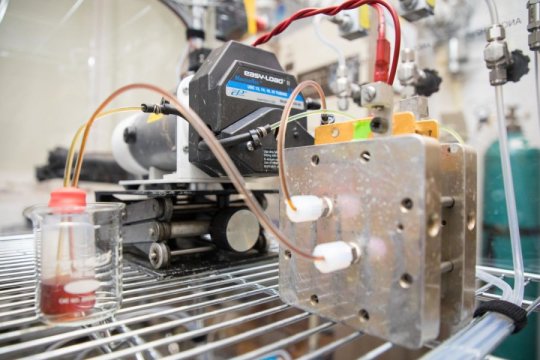[ad_1]
To sustain human civilization in the future, clean energy sources must be harnessed to replace the fossil fuels that are now polluting our atmosphere. Solar and wind energy can supply all the necessary energy. However, storage will be needed when the sun is not shining and the wind is not blowing.
Organic flow batteries are a potentially safer, less expensive alternative to lithium ion batteries and vanadium flow batteries for large-scale renewable energy storage.
Now, Harvard researchers have demonstrated a new organic molecule that outlives and outperforms its predecessors, offering the longest-lasting high-performance organic flow battery to date. Nicknamed the Methuselah quinone — after the longest-lived Biblical figure — this molecule could usefully store and release energy many tens of thousands of times over multi-year periods.
The research is published in the journal Joule.
The research was co-led by Roy Gordon, the Thomas Dudley Cabot Professor of Chemistry and Professor of Materials Science, and Michael Aziz, the Gene and Tracy Sykes Professor of Materials and Energy Technologies at the Harvard John A. Paulson School of Engineering and Applied Sciences (SEAS).
“We designed and built a new organic compound that can store electrical energy and also has a very long life before it decomposes,” said Gordon. “We discovered degradation processes of the molecules that we previously used in flow batteries. Then we created new, more stable molecules that avoid these problems.”
“In previous work, we had demonstrated a chemistry with a long lifespan but low voltage, which leads to low energy storage per molecule, which leads to high cost for a given amount of energy stored,” said Aziz. “Now, we have the first chemistry that has both long-term stability and comes in at more than one volt, which is commonly considered the threshold for commercial deployment. I believe it is the first organic-based flow battery that meets all of the technical criteria for practical implementation.”
The new chemistry builds off previous research led by Aziz and Gordon. The Methuselah molecule is a modified quinone, an abundant, naturally occurring molecule integral to biological processes like photosynthesis and cellular respiration. Collaborating with theoretical chemistry Professor Alán Aspuru-Guzik, their research team characterized the degradation process of previous quinone molecules in flow batteries and made modifications to increase the calendar life.
In experiments in their laboratories, the Methuselah molecule had a fade rate of less than 0.01 percent per day and less than 0.001 percent per charge/discharge cycle — which extrapolates to less than 3 percent degradation over the course of a year — and useful operation for tens of thousands of cycles.
Methuselah also proved highly soluble, meaning it can store more energy in a smaller space. It operates in a weak alkaline electrolyte, reducing the cost of the battery by allowing the use of inexpensive containment materials and an inexpensive polymer membrane to separate the positive and negative terminals.
All of these advances drive down the cost of storage and may make organic storage chemistries cost-effective for long-duration discharge.
“This research demonstrates the potential of organics,” said David Kwabi, a postdoctoral fellow at SEAS and co-first author of the paper. “We show that organic molecules are a viable, long-lasting, cost-effective alternative to expensive vanadium batteries.”
The research was supported by the U.S. DOE Office of Electricity energy storage program, by the Advanced Research Projects Agency — Energy, by Innovation Fund Denmark, by the Massachusetts Clean Energy Technology Center, and by the Harvard School of Engineering and Applied Sciences.
“This important work represents a significant advance towards low cost, long duration flow batteries,” said Imre Gyuk, Director of DOE’s Office of Electricity storage program. “Such devices are needed to allow the electric grid to absorb increasing amounts of green but variable renewable generation.”
With assistance from Harvard’s Office of Technology Development (OTD), the researchers are seeking commercial partners to scale up the technology for industrial applications. Harvard OTD has filed a portfolio of pending patents on innovations in flow battery technology.
[ad_2]















